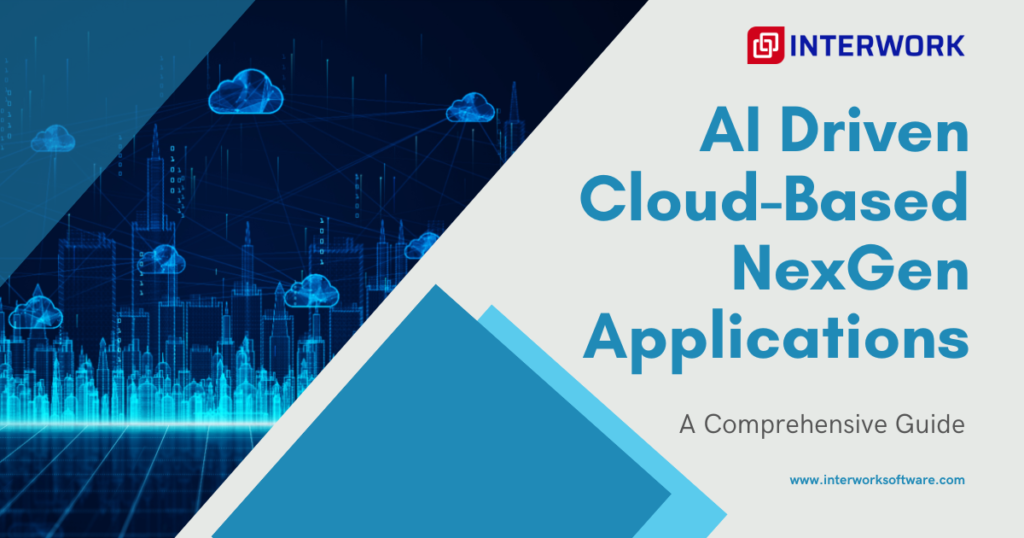How IoT and 5G Are Shaping Automotive Technology
The car manufacturing sector is altering the major trend in…
Technology partner helping businesses innovate and drive digital transformation
We understand your business better than anybody else, thanks to our domain consultants. Together with the technology experts, these domain consultants bring in years of experience to help you navigate through your technical and business challenges.
Interwork’s exclusive product approach is the cornerstone for all software engineering services that help build and design digital products using industry standards and enterprise agility frameworks. Our product strategy and management solutions, cross-channel mobile apps, DevOps transformation, and agile practices help businesses team up with us.
Embracing digital technology has never been more critical. In an era where technology is breaking down age-old barriers, businesses must create digital experiences that are consistent and connected. Our Nexgen services will enable you to win your customers’ and employees’ loyalty and trust in an environment of digital information proliferation.
Businesses can get an integrated environment with IoT, business processes, and IT consulting. Digital solutions help increase efficiency and simplify operations. Our role as a digital solution provider is to provide customers with bespoke digital experiences that enhance customer retention and open up new business prospects. At Interwork, we deliver cutting-edge services to businesses using the latest tech.
No matter where your apps exist, whether your own servers, third-party clouds, or a mix of both, we’re your one-stop cloud service provider. We can help you upgrade and migrate your apps without a hitch. As part of our cloud services, we make it easy for you to move to the cloud of your choice and keep your apps running smoothly.
Power Your Business with Scalable, Secure & Smart IT Infrastructure Solutions.
In today’s fast-evolving digital landscape, your IT infrastructure should do more than just function it should fuel innovation, safeguard operations, and drive sustainable growth. At Interwork, we empower businesses with next-generation Managed IT Infrastructure Services that ensure 24/7 reliability, advanced security, and seamless scalability.
Whether you’re a growing startup or an established enterprise, our tailored solutions are designed to reduce overhead, eliminate downtime, and accelerate transformation all while keeping your business future-ready.
You can create an omnichannel experience by connecting all your touchpoints, devices, and channels. Interwork’s strategy and UX team use the latest technology tools to develop intuitive and specific solutions for each client. A good UX design involves collaboration and iteration. We aim to make digital experiences fun and useful for clients and users.
Interwork’s end-to-end quality assurance and testing services helps enterprises manage an increasingly complex technology landscape through various solutions. Our quality assurance practices have enabled global enterprises to gain consistency, improve productivity, lower costs, and boost profits. With the help of our quality assurance frameworks, practices, and solutions, we help our clients mitigate technical and business risks.
Interwork believes that providing the target audience with a superior product or service will positively impact them. Therefore, Interwork helps startups refine their product ideas. We use technology-driven accelerators, business models, skilled resources, standardized processes, and profound experience to help startups visualize, conceptualize and execute their business requirements, turning them into profitable ventures.
No matter how well you care for your software, technical errors, system failures, faults will always occur. When that happens, don’t let it sabotage your productivity or impact your business. Reach out to us, with Interwork’s help desk and operations support offerings, we walk that extra mile to make sure your business runs 24X7.
You need the right team and the right skill set for your project to succeed. With Interwork’s IT Staffing Services, you can hire qualified and experienced resources quickly ramp up your application development initiatives. Whether you need a prototype or a full-scale enterprise app, we’ve covered you.
Interwork’s exclusive product approach is the cornerstone for all software engineering services that help build and design digital products using industry standards and enterprise agility frameworks. Our product strategy and management solutions, cross-channel mobile apps, DevOps transformation, and agile practices help businesses team up with us.
Embracing digital technology has never been more critical. In an era where technology is breaking down age-old barriers, businesses must create digital experiences that are consistent and connected. Our Nexgen services will enable you to win your customers’ and employees’ loyalty and trust in an environment of digital information proliferation.
Businesses can get an integrated environment with IoT, business processes, and IT consulting. Digital solutions help increase efficiency and simplify operations. Our role as a digital solution provider is to provide customers with bespoke digital experiences that enhance customer retention and open up new business prospects. At Interwork, we deliver cutting-edge services to businesses using the latest tech.
No matter where your apps exist, whether your own servers, third-party clouds, or a mix of both, we’re your one-stop cloud service provider. We can help you upgrade and migrate your apps without a hitch. As part of our cloud services, we make it easy for you to move to the cloud of your choice and keep your apps running smoothly.
Power Your Business with Scalable, Secure & Smart IT Infrastructure Solutions.
In today’s fast-evolving digital landscape, your IT infrastructure should do more than just function it should fuel innovation, safeguard operations, and drive sustainable growth. At Interwork, we empower businesses with next-generation Managed IT Infrastructure Services that ensure 24/7 reliability, advanced security, and seamless scalability.
Whether you’re a growing startup or an established enterprise, our tailored solutions are designed to reduce overhead, eliminate downtime, and accelerate transformation all while keeping your business future-ready.
You can create an omnichannel experience by connecting all your touchpoints, devices, and channels. Interwork’s strategy and UX team use the latest technology tools to develop intuitive and specific solutions for each client. A good UX design involves collaboration and iteration. We aim to make digital experiences fun and useful for clients and users.
Interwork’s end-to-end quality assurance and testing services helps enterprises manage an increasingly complex technology landscape through various solutions. Our quality assurance practices have enabled global enterprises to gain consistency, improve productivity, lower costs, and boost profits. With the help of our quality assurance frameworks, practices, and solutions, we help our clients mitigate technical and business risks.
Interwork believes that providing the target audience with a superior product or service will positively impact them. Therefore, Interwork helps startups refine their product ideas. We use technology-driven accelerators, business models, skilled resources, standardized processes, and profound experience to help startups visualize, conceptualize and execute their business requirements, turning them into profitable ventures.
No matter how well you care for your software, technical errors, system failures, faults will always occur. When that happens, don’t let it sabotage your productivity or impact your business. Reach out to us, with Interwork’s help desk and operations support offerings, we walk that extra mile to make sure your business runs 24X7.
You need the right team and the right skill set for your project to succeed. With Interwork’s IT Staffing Services, you can hire qualified and experienced resources quickly ramp up your application development initiatives. Whether you need a prototype or a full-scale enterprise app, we’ve covered you.



The car manufacturing sector is altering the major trend in…
In today’s rapidly evolving business environment, staying competitive means embracing…
The transportation industry is in a time of great change,…
Businesses in the ever-evolving digital age are choosing between adapting…

As the demand for intelligent and data-driven applications continues to rise, integrating cloud-based AI models into your app has become a crucial step towards staying competitive in the ever-evolving tech landscape. To ensure the success of your project, it’s essential to carefully choose the right technology stack. In this article, we’ll explore key considerations and provide suggestions for an effective technology stack for your app leveraging cloud-based AI models.
The first decision you’ll need to make is selecting a cloud platform to host your AI models. Leading cloud providers like AWS, Azure, and Google Cloud offer a range of services tailored for AI and machine learning. Consider factors such as scalability, cost, ease of integration, and available AI services. AWS’s SageMaker, Azure’s Azure Machine Learning, and Google Cloud’s AI Platform are excellent choices for managing and deploying AI models seamlessly.
Choosing the right frameworks and libraries is crucial for developing, training, and deploying AI models efficiently. TensorFlow and PyTorch are two dominant frameworks, each with its strengths. TensorFlow is known for its scalability and deployment capabilities, while PyTorch is favored for its dynamic computational graph and ease of use. Your choice may depend on the specific requirements of your AI models and the expertise of your development team.
Containerization simplifies the deployment process by encapsulating the application and its dependencies into a container. Docker is a popular choice for containerization, providing consistency across different environments. For orchestrating and managing containers at scale, Kubernetes is widely adopted. Kubernetes ensures efficient resource utilization, scaling, and fault tolerance, making it an excellent fit for deploying AI models on the cloud.
Efficient data storage and management are fundamental for AI applications. Cloud-based databases like Amazon DynamoDB, Azure Cosmos DB, or Google Cloud Firestore offer scalable, NoSQL solutions for storing and retrieving data. Additionally, cloud storage services such as Amazon S3, Azure Blob Storage, or Google Cloud Storage are ideal for handling large datasets used in training AI models.
Building a modular and scalable architecture is essential for managing the complexity of AI applications. Implementing a microservices architecture allows for the development, deployment, and scaling of independent services. An API gateway, such as AWS API Gateway or Azure API Management, can streamline communication between microservices, ensuring seamless integration and improved maintainability.
Embrace DevOps practices to automate the development, testing, and deployment processes, enhancing collaboration and reducing time-to-market. Tools like Jenkins, GitLab CI, or GitHub Actions facilitate CI/CD pipelines, ensuring smooth and rapid deployment of updates and improvements to your AI-powered app.
Implement robust monitoring and analytics tools to gain insights into your application’s performance, user behavior, and the health of your AI models. Services like AWS CloudWatch, Azure Monitor, or Google Cloud Monitoring can help track key metrics, detect anomalies, and optimize resource utilization.
Creating a mobile app that leverages AI involves selecting the right technology stack to handle natural language generation and processing. Here’s a suggested tech stack for building a new generation mobile app.

Name | Developer |
BERT | |
XLNet | |
GPT-2 | OpenAI |
GPT-3 | OpenAI |
GPT-Neo | EleutherAI |
GPT-J | EleutherAI |
Megatron-Turing NLG | Microsoft and Nvidia |
Ernie 3.0 Titan | Baidu |
Claude | Anthropic |
GLaM (Generalist Language Model) | |
Gopher | DeepMind |
LaMDA (Language Models for Dialog Applications) | |
GPT-NeoX | EleutherAI |
Chinchilla | DeepMind |
PaLM (Pathways Language Model) | |
OPT (Open Pretrained Transformer) | Meta |
YaLM 100B | Yandex |
Minerva | |
BLOOM | Large collaboration led by Hugging Face |
Galactica | Meta |
AlexaTM (Teacher Models) | Amazon |
LLaMA (Large Language Model Meta AI) | Meta |
GPT-4 | OpenAI |
Cerebras-GPT | Cerebras |
Falcon | Technology Innovation Institute |
BloombergGPT | Bloomberg L.P. |
PanGu-Σ | Huawei |
OpenAssistant | LAION |
Jurassic-2 | AI21 Labs |
PaLM 2 (Pathways Language Model 2) | |
Llama 2 | Meta |
Falcon 180B | Technology Innovation Institute |
Mistral 7B | Mistral |
OpenHermes-7B | Nous Research |
OpenHermes-15B | Nous Research |
Service type | Description | AWS | Azure | GCP |
Machine Learning | Train, fit, validate, and deploy ML models | SageMaker | Machine Learning | Vertex AI |
Jupyter notebooks | Write data analyses and reports | SageMaker Notebooks | Notebooks | Colab |
Data science/machine learning VM | Virtual machines tailored to data work | Deep Learning AMIs | Data Science Virtual Machines | Deep Learning VM |
AutoML | Automatically build ML models | SageMaker | Machine Learning Studio, | Vertex AI Workbench |
|
|
| Automated ML |
|
Natural language Processing AI | Analyze text data | Comprehend | Text Analytics | Natural Language AI |
Recommendation AI | Product recommendation engine | Personalize | Personalizer | Recommendations AI |
Document capture | Extract text from printed text & handwriting | Textract | Form Recognizer | Document AI |
Computer vision | Image classification, object detection & other AI with image data | Rekognition, Panorama, Lookout for Vision | Cognitive Services for Vision | Vision AI |
Speech to text | Speech transcription | Transcribe | Cognitive Services for Speech to Text, Cognitive Services for Speaker Recognition | Speech-to-Text |
Text to speech | Speech generation | Polly | Cognitive Services for Text to Speech | Text-to-Speech |
Translation AI | Convert text between human languages | Translate | Cognitive Services for Speech Translation, Translator | Translation AI |
Video Intelligence | Video indexing and asset search | Rekognition Video | Video Indexer | Video Intelligence API |
AI agents | Virtual assistants and chatbots | Lex, Alexa Skills kit | Bot Service, Cognitive Services for Conversational Language Understanding | Dialogflow |
Human-in-the-loop | Human-based quality control for AI | Augmented AI (A2I) | Cognitive Services Content Monitor | N/A |
Selecting the right technology stack for your cloud-based AI-powered app is a critical decision that will impact your project’s success. By carefully considering factors such as cloud platform, frameworks, containerization, data management, architecture, DevOps practices, and monitoring tools, you can build a scalable, efficient, and future-proof application that harnesses the power of AI to meet your users’ needs. Regularly evaluate and update your technology stack to stay abreast of emerging technologies and ensure your app remains at the forefront of innovation.
https://wikibon.com/breaking-analysis-google-goes-all-in-on-the-ai-cloud/
https://www.channelinsider.com/cloud-computing/aws-vs-azure-vs-google-cloud/
https://www.datacamp.com/cheat-sheet/aws-azure-and-gcp-service-comparison-for-data-science-and-ai